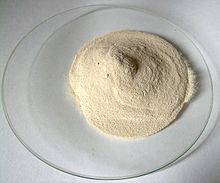
| |

| |
| Names | |
|---|---|
| Preferred IUPAC name
Calcium acetylide | |
| Systematic IUPAC name
Calcium ethynediide | |
| Other names
Calcium percarbide
Calcium carbide Calcium dicarbide | |
| Identifiers | |
3D model (JSmol)
|
|
| ChemSpider | |
| ECHA InfoCard | 100.000.772 |
| EC Number |
|
PubChem CID
|
|
| UNII | |
CompTox Dashboard (EPA)
|
|
| |
| |
| Properties | |
| CaC2 | |
| Molar mass | 64.099 g/mol |
| Appearance | White powder or colorless crystals, grey/brown/black crystals if impure |
| Density | 2.22 g/cm3 |
| Melting point | 2,160 °C (3,920 °F; 2,430 K) |
| Boiling point | 2,300 °C (4,170 °F; 2,570 K) |
| Reacts to produce Acetylene | |
| Structure[1] | |
| Tetragonal (I phase) Monoclinic (II phase) Monoclinic (III phase) | |
| I4/mmm (I phase) C2/c (II phase) C2/m (III phase) | |
| 6 | |
| Thermochemistry | |
Std molar
entropy (S⦵298) |
70 J·mol−1·K−1 |
Std enthalpy of
formation (ΔfH⦵298) |
−63 kJ·mol−1 |
| Hazards | |
| Occupational safety and health (OHS/OSH): | |
Main hazards
|
Reacts with water to release acetylene gas[2] |
| GHS labelling: | |
 
| |
| Danger | |
| H260 | |
| NFPA 704 (fire diamond) | |
| 305 °C (581 °F; 578 K) (acetylene) | |
Except where otherwise noted, data are given for materials in their standard state (at 25 °C [77 °F], 100 kPa).
| |
Calcium carbide, also known as calcium acetylide, is a chemical compound with the chemical formula of CaC2. Its main use industrially is in the production of acetylene and calcium cyanamide.[3]
The pure material is colorless, while pieces of technical-grade calcium carbide are grey or brown and consist of about 80–85% of CaC2 (the rest is CaO (calcium oxide), Ca3P2 (calcium phosphide), CaS (calcium sulfide), Ca3N2 (calcium nitride), SiC (silicon carbide), C (carbon), etc.). In the presence of trace moisture, technical-grade calcium carbide emits an unpleasant odor reminiscent of garlic.[4]
Applications of calcium carbide include manufacture of acetylene gas, generation of acetylene in carbide lamps, manufacture of chemicals for fertilizer, and steelmaking.
- ^ Konar, Sumit; Nylén, Johanna; Svensson, Gunnar; Bernin, Diana; Edén, Mattias; Ruschewitz, Uwe; Häussermann, Ulrich (2016). "The many phases of CaC2". Journal of Solid State Chemistry. 239. Elsevier BV: 204–213. Bibcode:2016JSSCh.239..204K. doi:10.1016/j.jssc.2016.04.030. ISSN 0022-4596.
- ^ NFPA Hazard Rating Information for Common Chemicals. Northeastern University
- ^ Patnaik, Pradyot (2003). Handbook of Inorganic Chemical Compounds. McGraw-Hill. ISBN 0-07-049439-8.
- ^ Vincoli, Jeffrey Wayne (25 November 1996). Risk Management for Hazardous Chemicals. CRC Press. p. 429. ISBN 978-1-56670-200-3.
